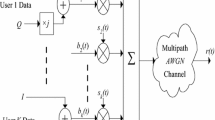Abstract
Decorrelating detectors were proposed as tools to combat the near-far problem in multi-user CDMA communication systems. They were also used as the first stage of many two-stage, multi-user signal separators to facilitate tentative decisions for the canceller stage. These decorrelators completely separate signals, but with relatively high additive noise. Different separators, which may not totally reject other signals, have been shown to result in better error probability with any value of interference energies. These separators can be implemented with an adaptive algorithm, termed “Bootstrap”, which can easily be used in situations where the cross-correlation matrix is unknown or the codes have been altered by the channel.
Similar content being viewed by others
References
S.Verdú, “Minimum probability of error for asynchronous Gaussian multiple access channels,” IEEE Trans. Infor. Theory, Vol. IT-32, No. 1, pp. 85–96, 1986.
R.Lupas and S.Verdú, “Linear multiuser detector for synchronous code division multiple access channels,” IEEE Trans. Infor. Theory, Vol. IT-35, No. 1, pp. 123–136, 1989.
R.Lupas and S.Verdú, “Near-far resistance of multiuser detectors in asynchronous channels,” IEEE Trans. Commun., Vol. COM-38, No. 4, pp. 496–508, 1990.
M.K.Varanasi and B.Aazhang, “Multistage detector in asynchronous code-division multiple-access communications,” IEEE Trans. Commun., Vol. COM-38, No. 4, pp. 509–519, 1990.
M.K.Varanasi and B.Aazhang, “Near-optimum detector in synchronous code-division multiple-access systems,” IEEE Trans. Commun., Vol. COM-39, No. 5, pp. 725–736, 1991.
Z.Siveski, Y.Bar-Ness, and D.W.Chen, “Error performance of a synchronous multiuser code division multiple access detector with a multidimensional adaptive canceller,” The Euro. Trans. Telecom. and Rel. Tech., Vol. 5, No. 6, pp. 719–724, 1994.
D.W. Chen, Z. Siveski, and Y. Bar-Ness, “Synchronous multiuser CDMA detector with a soft decision adaptive canceller,” The 28th Annual Conference on Information Sciences and Systems, Princeton, NJ, 1994.
Y. Bar-Ness and N. Sezgin, “Adaptive threshold setting for multi-user CDMA signal separators with soft tentative decision,” The 29th Annual Conference on Information Sciences and Systems, Baltimore, MD, 1995.
A.Duel-Hallen, “Decorrelating decision-feedback multiuser detector for synchronous code division multiple access channels,” IEEE Trans. Commun., Vol. COM-41, pp. 285–290, 1993.
U.Madhow and M.L.Honig, “MMSE interference suppression for direct-sequence spread-spectrum CDMA,” IEEE Trans. Commun., Vol. COM-42, No. 12, pp. 3178–3188, 1994.
S.Verdú, “Recent progress in multiuser detection,” Advances in Communication and Signal Processing, Springer-Verlag, Berlin-Heidelberg, Germany, pp. 66–77, 1989.
A. Dinc and Y. Bar-Ness, “Bootstrap: A fast unsupervised learning algorithm,” IEEE 1992 International Conference on Acoustics, Speech and Signal Processing, ICASSP'92, paper 43.8, San Francisco, CA, 1992.
Author information
Authors and Affiliations
Additional information
This work was supported in part by grant from Rome Air Force Lab, under contract F30602-94-c-0135.
Rights and permissions
About this article
Cite this article
Bar-Ness, Y., Punt, J.B. Adaptive “Bootstrap” CDMA multi-user detector. Wireless Personal Communications 3, 55–71 (1996). https://doi.org/10.1007/BF00333923
Issue Date:
DOI: https://doi.org/10.1007/BF00333923




